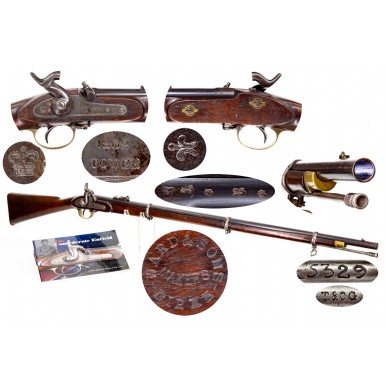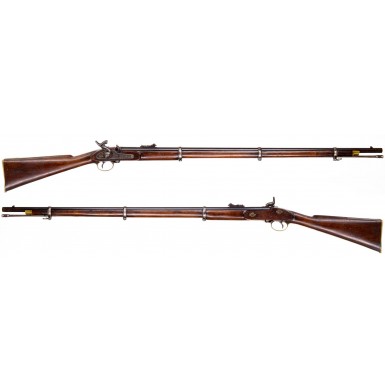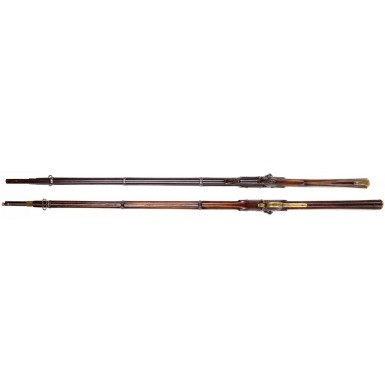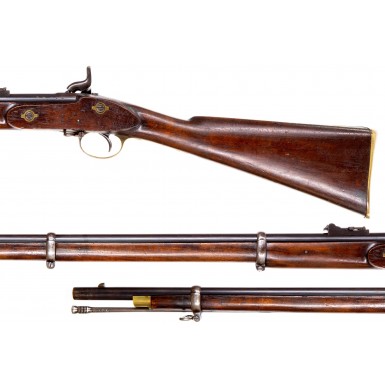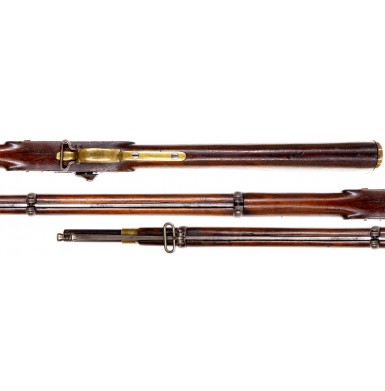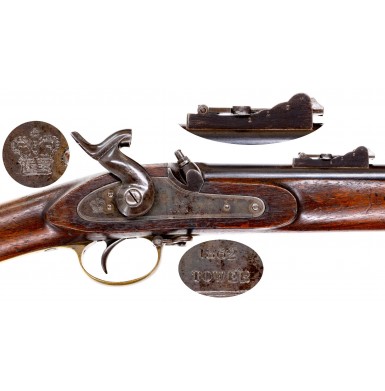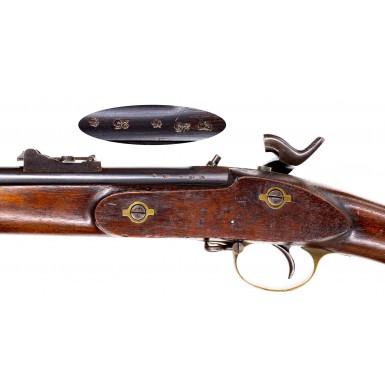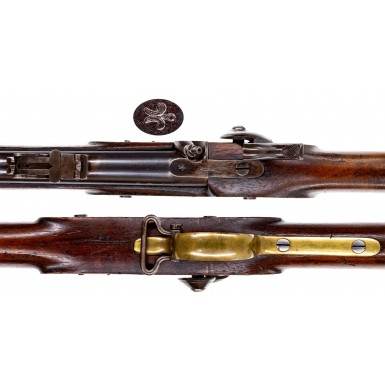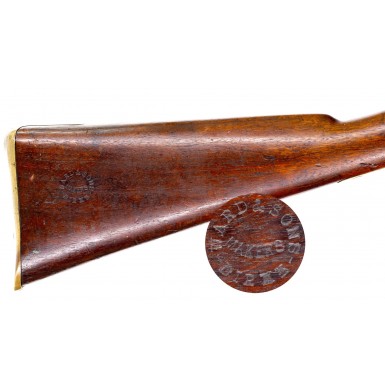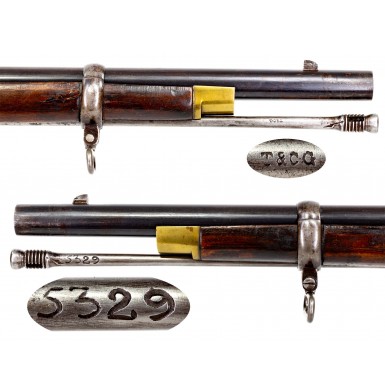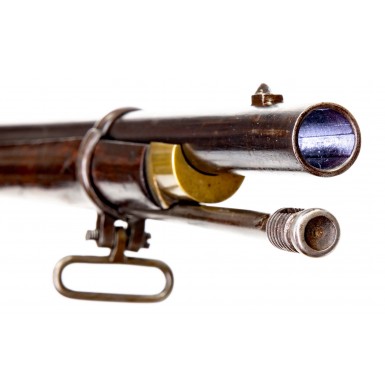About Excellent Pattern 1853 Enfield Rifle Musket Featured On The Cover of Steven Knott's Book "The Confederate Enfield"
- Product Code: FLA-3766-SOLD
- Availability: Out Of Stock
-
$1.00
The Pattern 1853 “Enfield” Rifle Musket was the second most used infantry long arm of the American Civil War. The Pattern 1853 Enfield was an important weapon in military long arm history as it was the first “small bore” rifled long arm to see general issue to all British military personnel, effectively making every soldier a “rifleman” and eliminating both the smoothbore musket and the large caliber “Minié Rifle” as legitimate battlefield weapons. The reduced caliber .577” bore was a significant ballistic improvement over the .702” bore of the preceding British Pattern 1851 Minié Rifle and the overall design of the gun was the epitome of muzzle loading military firearms technology of the time. The Pattern 1853 would significantly influence the design of the new American Model 1855 Rifle Musket (as well as its subsequent replacements the M1861, Special Model 1861 and M1863/64) and would be the last of the percussion ignition, muzzleloading arms to see general service with the British military, being replaced by breechloading rifles about the time the American Civil War came to an end.
The P1853 was so revolutionary and so well designed that the “Enfield” was effectively the “AK-47” of the era, becoming the either the standard battle rifle for nearly every country in the world, or an equivalent “substitute standard” for those countries that selected another model as their standard issue rifle musket. Several million “Enfields” saw use across the globe during mid-19th century, so it is often difficult to determine if a specific Enfield rifle or rifle musket was exported for use the American Civil War, especially in the absence of specific US or CS markings on the gun. However, with somewhere in the neighborhood of one million Enfields being purchased and used by both sides combined during the course of the war, the very fact that a commercially made Pattern 1853 Enfield Rifle Musket that is devoid of any British military or colonial marks is in the United States suggests that the gun may well be a veteran of that horrible conflict
Offered here is an exceptional condition Pattern 1853 Type III Enfield Rifle Musket is in VERY FINE to NEAR EXCELLENT condition. This gun featured at the cover image of a book by noted arms collector, history and author Captain Steven W. Knott, U.S.N. (Retired), The Confederate Enfield. While the gun itself bears no specific mark that indicates that it was a Confederate purchase, a Confederate inventory control numbered ramrod is in the ramrod channel under the barrel. The rod is engraved with the number 5329 and is also featured in the book, where it is pictured on page 19. A copy of Captain Knott’s book accompanies the gun and inside the cover is written: “Gun on cover belongs to me. Ram rod for this gun is on page 19.”
The gun itself is a classic example of the typical Civil War imported Enfield rifle musket. The gun is devoid of any British military markings and is a typical Birmingham made contract gun for commercial sale that was almost certainly destined for export. As a Birmingham produced gun it is also a wonderful example of the way the Birmingham Small Arms Trade worked during the mid-19th century with a master contractor assembling the gun from a variety of components made not only by himself but by other B.S.A.T. members. In this case the master contractor was Ward & Sons and is clearly stamped with a maker’s roundel in the obverse stock that reads: - WARD & SONS – BIRMM in a circle around the word MAKERS. According to English Gunmakers – The Birmingham & Provincial Gun Trade in the 18th & 19thCentury by DeWitt Bailey, the firm of Ward & Sons operated at 24-27 Bath Street, Snow Hill, Birmingham from 1859 through 1900. Bailey notes that “the company was one of the last firms to produce African and Long Dane guns.” The term “Dane Gun” referred to a pattern of long flintlock musket used in trade with the Africans by the Dano-Norwegians prior to the 19th century. By the 19th century the term applied to most of the long barreled trade musket produced for the African trade by English and Belgian gunmakers. Further research provided by Mike Nicholls in our book The English Connection, indicates the firm has its origins in the 1820s and remained in operation through the 1960s, although no longer under the “Ward & Son” name. Birmingham based cutler Horace Chavasse, who would help to finance the blockade running efforts of William Grazebrook, would purchase a number of Enfield “short rifles” from Ward & Son, which would be part of the cargo of the ill-fated blockade runner the Modern Greece. There is thus little doubt that like most Birmingham gunmakers of the period, Ward & Son certainly manufactured arms that were subsequently sold to the Confederacy. In addition to the Ward & Son stock roundel, the Ward & Son mark is found inside the lock and the name WARD is stamped under the barrel.
The lock of the gun is clearly marked with the typical British “Crown” to the rear of the hammer, but without the accompanying “VR” underneath that normally denotes British government ownership. The lock is stamped 1862 / TOWER forward of the hammer. The interior of the lock is marked WARD & SON over the mainspring and there is no lock maker’s mark found at the mainspring boss, suggesting that Ward & Son produced the lock as well. Two sets of assembly mating marks are found on the top edge of the lock, a \ | / and \ / | | |. The lock mounting screws both bear the longer \ / | | | mark, while the bottom of the barrel has the shorter \ | / mark. The breech plug tang screw also has the three-slash marl \ | / and both the \ | / and longer \ / | | | mark are found in the ramrod channel of the stock. This pattern of using two sets of mating marks, essentially one for the lock and mating the lock to the stock and one for the barrel and mating it to the stock was an archaic practice of the 18th and early 19th century and by the mid-19th century most Birmingham gun makers were using a single mating mark throughout the entire gun instead of two sets. The presence of two sets may indicate two different workmen who assembled the gun or acted as the “setter up”, one finishing the lock inletting and fitting it to the stock and the other finishing the barrel channel and fitting it to the stock.
The barrel is marked at the breech with the three usual Birmingham commercial proofs; a Provisional Proof, a Definitive Proof and a Definitive View mark. These marks are separated by a pair of 25 gauge marks, indicating that the gun is “25 bore” or .577 caliber. The top of the nocksform is additionally stamped with the “Prince of Wales Feathers”, a mark very much like the French fleur-de-lis. The mark appears from time to time on arms produced by companies that held a warrant to produce arms for the Prince of Wales. The underside of the barrel bears the mark of Birmingham gun and barrel maker Charles Reeves and is stamped CHAS. REEVES. As previously noted, the bottom of the barrel is also stamped WARDand bears a three-slash mating mark.
As noted, the gun is in VERY FINE to NEAR EXCELLENT condition overall and is quite crisp and untouched. The gun appears to be 100% original, complete and correct, with nearly every part that has a mating mark displaying the expected file slashes. The gun retains about 85%+ of its original deep, rich, rust blued finish on the exterior of the barrel, with even more blue under the barrel where it has been protected by the stock. The exposed blue shows some thinning and fading, most notably at the nocksform of the breech and around the muzzle where repeated mounting and removing of a socket bayonet has created some wear and loss. The areas where the blue has thinned or worn have a smooth pewter gray patina. The metal is almost entirely smooth with only some scattered light flecks of minor oxidation shot through the blued finish and a few tiny freckles of minor pinpricking scattered here and there. The bore of the gun is in VERY FINE condition. The bore is mostly bright with fine, crisp rifling and shows only some lightly scattered minor oxidation and a few scattered patches of minor pinpricking. The lock of the gun retains about 90%+ of its original color casehardened finish which remains about 50%+ vivid. The lock retains some lovely muted blue, purple, brown and gray mottling and is very attractive, with the coloring simply subdued and duller than it was when the lock was new more than one hundred and fifty years ago. The lock does show some scattered surface oxidation, but this does not detract in any way. The interior of the lock retains strong case coloring as well and some lovely blue on the internal parts. The lock is mechanically fine and functions exactly as it should on all positions. The gun retains its complete and original rear sight, as well as the original combination front sight and socket bayonet lug. The rear sight is missing the mounting screw for the ladder spring, but the sight design keeps the spring in place and the sight remains fully functional even with this tiny screw missing. The gun retains both original sling swivels, one on the front of the brass triggerguard and the other on the tension screw for the upper barrel band. The original screw retention “doughnuts” are present on all three of the barrel band tension screws, a tiny part that is often missing from an Enfield when it is found today. An original, Confederate inventory numbered full-length ramrod is in the channel under the barrel and retains fine threads at the end. The rod was produced by the Birmingham firm of Thomas & Charles Gilbert and is marked T&CG near the jag head. The Gilbert company went out of business sometime during 1862 and is not found in the directories after that year. As previously mentioned, the inventory number 5329 is engraved on the ramrod shank, definitively identifying it as a Confederate ramrod. The brass furniture has rich golden patina that is very attractive and matches the high condition of the gun’s finish very well. The stock is in VERY FINE to NEAR EXCELLENT condition as well. The wood remains extremely crisp with some feathery open grain still apparent to the touch. The wood to metal fit of the gun is wonderfully executed throughout, with no slop or gapping present. The stock is full-length, solid and free of any breaks, cracks or repairs. The stock has an attractive rich brown color with some reddish tones and an attractive grain. The stock retains extremely sharp lines throughout and equally crisp edges and shows no indication of having ever been sanded. The stock does not even appear to have been cleaned. The stock does show a number of scattered bumps, dings, scuff, scrapes and some minor dents in the wood, as would be expected from a more than 150-year-old military musket but remains extremely crisp and sharp overall.
Overall, this is really fantastic example of a Civil War era Ward & Sons produced Pattern 1853 Enfield Rifle Musket. The gun retains an immense amount of finish and an amazingly crisp stock for a military gun of its age and is in a really remarkable state of preservation. The gun has tons of eye appeal because of this wonderful condition. No doubt the attractive case colors on the lock and crisp wood of the lock mortise combined to help Captain Knott choose this exceptional gun to grace the cover of his book . The presence of the Confederate inventory number engraved ramrod also adds an additional $1,000 to $1,500 to the value of the gun. The gun is accompanied by the copy of Capt. Knotts book that notes on the inner cover that this is the gun pictured there, with the ramrod pictured on page 19. If you have been waiting to add a really outstanding example of a Civil War era Enfield to your collection, now is your chance to get a really fantastic, “no apologies” published gun that you will be extremely pleased to own and display.
SOLD
Tags: About, Excellent, Pattern, 1853, Enfield, Rifle, Musket, Featured, On, The, Cover, of, Steven, Knott's, Book, The, Confederate, Enfield

